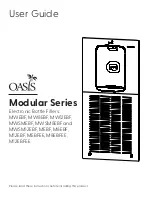
page A – 31
WheatNet-IP
/ Apr 2009
A P P E N D I C E S
WheatNet-IP
/ Feb 2013
page A – 29b
6. These functions are programmed on logic-only destinations to use with program-
mable (spare) buttons on a surface. The logic-only destination must be routed to the
surface source signal that has the logic for the desired spare button pre-programmed
on it. On an E-6, for example, there are 14 such sources, named (by default) Spare1,
Spare2, and so on, through Spare14. Other surfaces may have fewer buttons, and thus
fewer sources.
Switch n (where n = any integer between 1 and 14 inclusive) – logic output to read
a spare button. No matter which spare button is used, the function must be Switch 1;
use of the remaining values for n
is currently undefined.
Switch LED n (where n = any integer between 1 and 14 inclusive) – logic input
to light the LED in a spare button. No matter which spare button is being lit, the
function must be Switch LED 1; use of the remaining values for n is currently
undefined.
7. These functions are by design undefined, to be used in any manner desired. They
may be associated with audio signals or programmed on logic-only signals as needed,
and may be used with input or output logic as required. Keep in mind the master rules
of system logic: (1) a logic input must connect to a logic output; and (2) a common
function name must be used at both ends of a logic connection.
User n (where n = any integer between 1 and 500 inclusive)
Category 3: Discrete Logic
A third class of logic functions available in WheatNet-IP systems is discrete logic.
These are logic functions that work on their own, with no specific association to any
audio signals. Typical of these is a situation where a button press in one area lights a
light in another, or a satellite receiver detects a tone and closes a relay that is to be used
to start a record machine. The WheatNet-IP system can handle this type of logic func-
tion very easily. As in the associated logic case, you need only to wire the specific logic
connections on your devices to the logic ports on any conveniently located BLADE. All
of the control communications between BLADEs happens over the LAN connection.
As an example let’s take the case of a profanity delay DUMP control. We’ll assume
we have a switch panel located by our talent microphone and we have an airTools-6000
Delay unit located in our rack room. BLADE #5, located in the studio, has available
logic ports, as does BLADE #19 located in the rack room. We’ll use LIO #3 in BLADE
#5 and LIO #1 in BLADE #19. Your system will likely have different BLADE and logic
port numbers than these in the example; just substitute your BLADE ID#s as necessary.
To activate the DUMP function the airTools Delay unit requires a momentary clo-
sure on pins #7 and #13 of its DB-25 GPIO control connector. First, in the rack room,
wire the Delay unit GPIO connector pins 7 and 13 to the first RJ-45 logic connector
on BLADE #19, pin #1 and #2 respectively. In the studio you will need to wire the
normally open contacts of the DUMP switch to the BLADE #5 pins #1 and #4.
















































